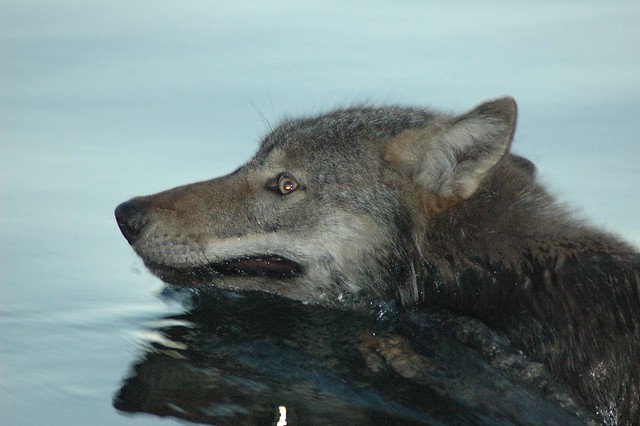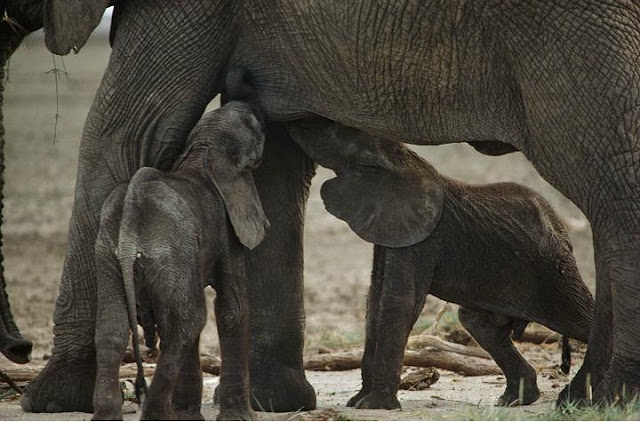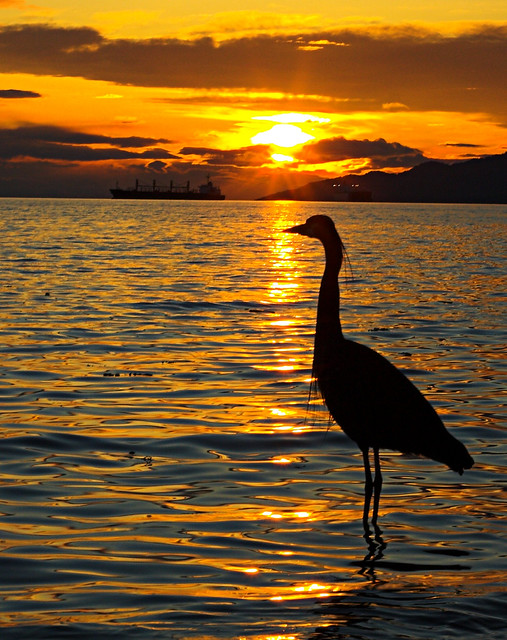1- In order for a new wolf cub to urinate, its mother has to massage its belly with her warm tongue.
2- The Vikings wore wolf skins and drank wolf blood to take on the wolf’s spirit in battle. They also viewed real wolves as battle companions or hrægifr (corpse trolls).
3- The earliest drawings of wolves are in caves in southern Europe and date from 20,000 B.C.
4- Wolves do not make good guard dogs because they are naturally afraid of the unfamiliar and will hide from visitors rather than bark at them.
5- The autoimmune disease Systemic Lupus Erythmatosus (SLE), or lupus, literally means wolf redness, because in the eighteenth century, physicians believed the disease was caused by a wolf bite.
6- Wolves are the largest members of the Canidae family, which includes domestic dogs, coyotes, dingoes, African hunting dogs, many types of foxes, and several kinds of jackals.
7- Wolves run on their toes, which helps them to stop and turn quickly and to prevent their paw pads from wearing down.
8- Wolves have about 200 million scent cells. Humans have only about 5 million. Wolves can smell other animals more than one mile (1.6 kilometers) away.
9- Where there are wolves, there are often ravens (sometimes known as “wolf-birds”). Ravens often follow wolves to grab leftovers from the hunt—and to tease the wolves. They play with the wolves by diving at them and then speeding away or pecking their tails to try to get the wolves to chase them.
10- The Cherokee Indians did not hunt wolves because they believed a slain wolves’ brothers would exact revenge. Furthermore, if a weapon were used to kill a wolf, the weapon would not work correctly again.
11- The Japanese word for wolf means “great god.”
12- Under certain conditions, wolves can hear as far as six miles away in the forest and ten miles on the open tundra.
13- Wolves were once the most widely distributed land predator the world has ever seen. The only places they didn’t thrive were in the true desert and rainforests.
14- Among true wolves, two species are recognized: Canis lupus (often known simply as “gray wolves”), which includes 38 subspecies, such as the gray, timber, artic, tundra, lobos, and buffalo wolves. The other recognized species is the red wolf (Canis rufus), which are smaller and have longer legs and shorter fur than their relatives. Many scientists debate whether Canis rufus is a separate species.
15- Immense power is concentrated in a wolf’s jaw. It has a crushing pressure of nearly 1,500 pound per square inch (compared with around 750 for a large dog). The jaws themselves are massive, bearing 42 teeth specialized for stabbing, shearing, and crunching bones. Their jaws also open farther than those of a dog.
© R. J.B
16- The North American gray wolf population in 1600 was 2 million. Today the population in North America is approximately 65,000. The world population is approximately 150,000.
17- A hungry wolf can eat 20 pounds of meat in a single meal, which is akin to a human eating one hundred hamburgers.
18- A wolf pack may contain just two or three animals, or it may be 10 times as large.
19- Though many females in a pack are able to have pups, only a few will actually mate and bear pups. Often, only the alpha female and male will mate, which serves to produce the strongest cubs and helps limit the number of cubs the pack must care for. The other females will help raise and “babysit” the cubs.
20- Lower-ranking males do not mate and often suffer from a condition of stress and inhibition that has been referred to as “psychological castration.” Lower-ranking females are sometimes so afraid of the alpha female that they do not even go into heat.
21- An average size wolf produces roughly 1.2 cubic inches of sperm.
22- Wolves evolved from an ancient animal called Mesocyon, which lived approximately 35 million years ago. It was a small dog-like creature with short legs and a long body. Like the wolf, it may have lived in packs.
23- Currently, there are about 50,000 wolves in Canada; 6,500 in Alaska; and 3,500 in the Lower 48 States. In Europe, Italy has fewer than 300; Spain around 2,000; and Norway and Sweden combined have fewer than 80. There are about 700 wolves in Poland and 70,000 in Russia.
24- Between 1883 and 1918, more than 80,00 wolves were killed in Montana for bounty.
25- Adolph Hitler (whose first name means “lead wolf”) was fascinated by wolves and sometimes used “Herr Wolf” or “Conductor Wolf” as an alias. “Wolf’s Gulch” (Wolfsschlucht), “Wolf’s Lair” (Wolfschanze), and “Werewolf” (Wehrwolf) were Hitler’s code names for various military headquarters.
26- In the 1600s, Ireland was called “Wolf-land” because it had so many wolves. Wolf hunting was a popular sport among the nobility, who used the Irish wolfhound to outrun and kill wolves. The earliest record of an Irish wolfhound dates from Roman times in A.D. 391.
27- Recent scientists suggest that labeling a wolf “alpha” or “omega” is misleading because “alpha” wolves are simply parent wolves. Using “alpha” terminology falsely suggests a rigidly forced permanent social structure.
28- Biologists have found that wolves will respond to humans imitating their howls. The International Wolf Center in Minnesota even sponsors “howl nights” on which people can howl in the wilderness and hope for an answering howl.
29- Wolves have historically been associated with sexual predation. For example, Little Red Riding Hood, who wears a red cape that proclaims her sexual maturity, is seduced off the moral path by a wolf. The sex link endures in common clichés, such as describing a predatory man as “a wolf” or a sexy whistle as a “wolf whistle.”
30- Biologists describe wolf territory as not just spatial, but spatial-temporal, so that each pack moves in and out of each other's turf depending on how recently the “no trespassing” signals were posted.
31- The Greek god Apollo is sometimes called Apollo Lykios, the wolf-Apollo, and was associated with the wind and sun. In Athens, the land surrounding the temple of Apollo became known as the Lyceum, or the “wolf skin.”
32- In 1927, a French policeman was tried for the shooting of a boy he believed was a werewolf. That same year, the last wild wolves in France were killed.
33- When Europeans arrived in North America, wolves became the most widely hunted animal in American history and were nearly extinct by the beginning of the twentieth century. The U.S. Federal government even enacted a wolf eradication program in the Western states in 1915.
34- Dire wolves (canis dirus) were prehistoric wolves that lived in North America about two million years ago. Now extinct, they hunted prey as large as woolly mammoths.
35- A wolf can run about 20 miles (32 km) per hour, and up to 40 miles (56 km) per hour when necessary, but only for a minute or two. They can “dog trot” around 5 miles (8km) per hour and can travel all day at this speed.
36- The smallest wolves live in the Middle East, where they may weigh only 30 pounds. The largest wolves inhabit Canada, Alaska, and the Soviet Union, where they can reach 175 pounds.
37- Wolves howl to contact separated members of their group, to rally the group before hunting, or to warn rival wolf packs to keep away. Lone wolves will howl to attract mates or just because they are alone. Each wolf howls for only about five seconds, but howls can seem much longer when the entire pack joins in.
38- A light-reflecting layer on a wolf’s eye called the tapetum lucidum (Latin for “bright tapestry”) causes a wolf’s eyes to glow in the dark and may also facilitate night vision. While a wolf’s color perception and visual acuity maybe be inferior to a human’s, a wolf’s eyes are extremely sensitive to movement.
39- A wolf pup’s eyes are blue at birth. Their eyes turn yellow by the time they are eight months old.
40- In ancient Rome, barren women attended the Roman festival Lupercalia (named for the legendary nursery cave of Romulus and Remus) in the hopes of becoming fertile.
41- According to Pliny the Elder, a first-century Greek scholar, wolf teeth could be rubbed on the gums of infants to ease the pain of teething. He also reported that wolf dung could be used to treat both colic and cataracts.
42- The Aztecs used wolf liver as an ingredient for treating melancholy. They also pricked a patient’s breast with a sharpened wolf bone in an attempt to delay death.
43- During the Middle Ages, Europeans used powdered wolf liver to ease the pain of childbirth and would tie a wolf’sright front paw around a sore throat to reduce the swelling. Dried wolf meat was also eaten as a remedy for sore shins.f
44- The Greeks believed that if someone ate meat from a wolf-killed lamb, he or she ran a high risk of becoming a vampire.
45- During the reign of Edward the Confessor, which began in 1042, a condemned criminal was forced to wear a wolf-head mask and could be executed on a “wolf’s head tree” or the gallows where a wolf might be hanged next to him.
46- Werewolf (wer “man” + wulf “wolf”) trials (which can be distinguished from witchcraft trials) led to hundreds of executions during the 1600s. Men, women, and children—many of whom were physically and mentally handicapped—were put to death.
47- A male and female that mate usually stay together for life. They are devoted parents and maintain sophisticated family ties.
48- In approximately the year 800, Charlemagne founded a special wolf-hunting force, the Louveterie, which remained active until 1789. It was reactivated in1814, and the last French wolf was killed in 1927.
49- Britain’s King Edgar imposed an annual tax of 300 wolf skins on Wales. The Welsh wolf population was quickly exterminated.
50- In 1500, the last wolf was killed in England. In 1770, Ireland’s last wolf was killed. In 1772, Denmark’s last wolf was killed.
51- After hearing of “frightening spirits” in the woods with human features that walked on four legs, Reverend Singh in 1920 discovered a den with two cubs and two human girls, one around age 7 or 8, the other around 2. After being brought back to “civilization,” the younger one died within a year. Recently, authors have questioned the validity of this story as modern knowledge has revealed that wolf-like behavior is often seen in autistic or abused children.
52- Sextus Placitus, in his fifth-century B.C. Medicina de quadrupedibus (Medicinals from Animals), claims that sleeping with a wolf’s head under one’s pillow would cure insomnia.
53- In 1934, Germany became the first nation in modern times to place the wolf under protection. Influenced by Friedrich Nietzsche’s (1844-1900) and Oswald Spengler’s (1880-1936) belief that natural predators possessed more vigor and virility than their prey, the protection was probably more for an “iconic” wolf than the actual wolf, particularly since the last wolves in Germany were killed in the middle of the nineteenth century.
54- Unlike other animals, wolves have a variety of distinctive facial expressions they use to communicate and maintain pack unity.
55- Wolf gestation is around 65 days. Wolf pups are born both deaf and blind and weigh only one pound.
56- Between 6,000 and 7,000 wolf skins are still traded across the world each year. The skins are supplied mainly by Russia, Mongolia, and China and are used mainly for coats.
57- In India, simple wolf traps are still used. These traps consist of a simple pit, disguised with branches or leaves. The wolves fall in and people then stone them to death.
58- Wolves were the first animals to be placed on the U.S. Endangered Species Act list in 1973.
59- John Milton’s famous poem “Lycidas” derives its title from the Greek for “wolf cub,” lykideus.
60- In the Harry Potter universe, werewolf Remus Lupin’s name is directly related to the Latin word for wolf (lupus) and suggests an association with one of the founders of Rome, Remus, who was suckled by a wolf. The dual nature of Lupin’s werewolf nature suggests that in the Potter realm, there are two sides to everything.
61- The last wolf in Yellowstone Park was killed in 1926. In 1995, wolves were reintroduced and, after just ten years, approximately 136 wolves now roam the Park in about 13 wolf packs.
62- Wolves can swim distances of up to 8 miles (13 kilometers) aided by small webs between their toes.
References
a Bailey, Jill. 2005. Animals under Threat: Gray Wolf. Chicago, IL: Heinemann Library.
b Brandenburg, James and Judy Brandenburg. 2008. Face to Face with Wolves. Washington, D.C.: National Geographic Society.
c Dutcher, Jim and Jamie Dutcher. 2005. Living with Wolves. Seattle, WA: Braided River.
d Grambo, Rebecca L. 2005. Wolf: Legend, Enemy, Icon. Buffalo, NY: Firefly Books, Inc.
e Leach, Michael. 2003. Wolf: Habitats, Life Cycles, Food Chains, Threats. New York, NY: Raintree Steck-Vaughn Publishers.
f Ménatory, Anne. 2005. The Art of Being a Wolf. New York, NY: Barnes & Noble Books.
g Reid, Mary E. 2005. Wolves and Other Wild Dogs. Chicago, IL: World Book, Inc.






































